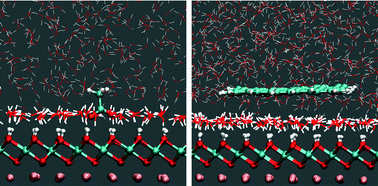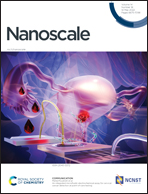Binding of polar and hydrophobic molecules at the LiCoO2 (001)-water interface: force field development and molecular dynamics simulations†
Abstract
A classical model in the framework of the INTERFACE force field has been developed for treating the LiCoO2 (LCO) (001)/water interface. In comparison to ab initio molecular dynamics (MD) simulations based on density functional theory, MD simulations using the classical model lead to generally reliable descriptions of interfacial properties, such as the density distribution of water molecules. Water molecules in close contact with the LCO surface form a strongly adsorbed layer, which leads to a free energy barrier for the adsorption of polar or charged molecules to the LCO surface. Moreover, due to the strong hydrogen bonding interactions with the LCO surface, the first water layer forms an interface that exhibits hydrophobic characters, leading to favorable adsorption of non-polar molecules to the interface. Therefore, despite its highly polar nature, the LCO (001) surface binds not only polar/charged but also non-polar solutes. As an application, the model is used to analyze the adsorption of reduced nicotinamide adenine dinucleotide (NADH) and its molecular components to the LCO (001) surface in water. The results suggest that recently observed redox activity of NADH at the LCO/water interface was due to the co-operativity between the ribose component, which drives binding to the LCO surface, and the nicotinamide moiety, which undergoes oxidation.



 Please wait while we load your content...
Please wait while we load your content...